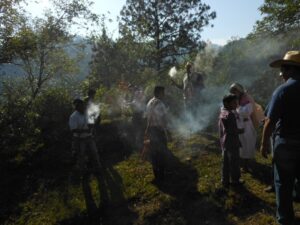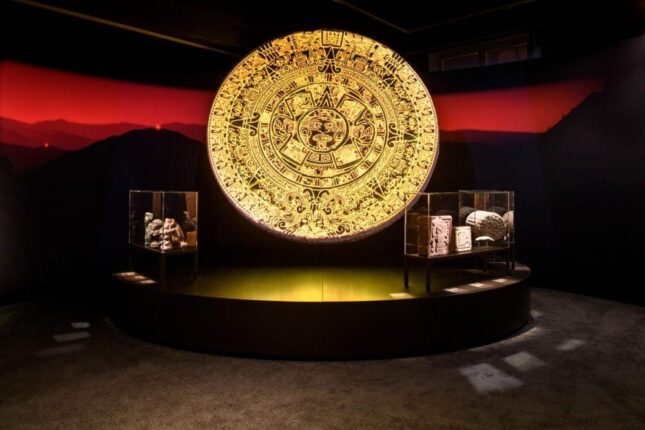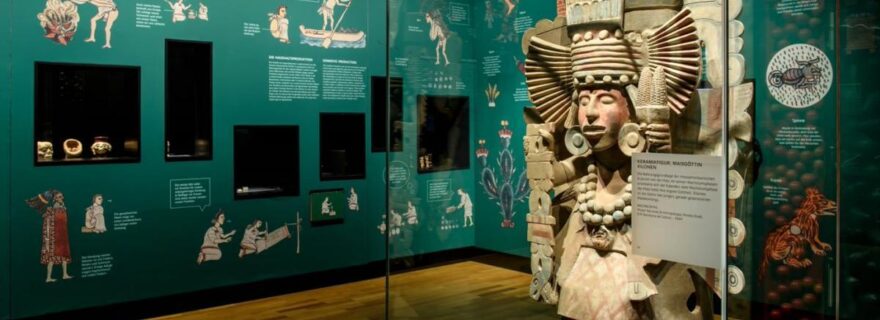An Ancient Civilization Alive Today
Lecturer Natalia Donner gave a critical tour of the Aztec exhibition in the Volkenkundig Museum in Leiden. One of her students reports about the excursion and the central question: how to frame objects from an ancient civilization that is still alive but marginalized today?
On the 27th of February students and staff of International Studies had the opportunity to join a guided tour of the Aztec exhibition at the Volkenkunde Museum by archeologist and IS lecturer, Dr. Natalia Donner. This was an invitation to explore the pre-colonial history of Latin American, to see how this history influences policies today, and to critically discuss how this often demonized civilization was represented in the exhibition.
Coloniality and the Importance of Visibility
“To begin with, the descendants recognize themselves as Mexica, not Aztecs,” explained our guide before we stepped inside. It would turn out to be a crucial insight. It shows that this “ancient civilization” has an impact on Mexico today through its descendants and not just by influencing the name of the country (Mexico from Mexica). We often look at these societies as past blocks or interesting previous stages of history in school, but as Dr. Donner explained and the beginning point of the exhibition made clear, this is not entirely the case. We entered and saw different forms of media including films, music, and YouTubers that not only mentioned the Aztecs but also spoke their language: Nahuatl. It was a way to remind ourselves about historical continuities and why it is important to maintain and show this side of history. Often the idea of history, as argued by Mignolo is seen through the influence of the Western perspective, or what counts as history is what came after colonization. The multimedia exhibit at the opening proposed that by keeping this unique language culture alive and visible, the people value their pre-colonial history and help to further exploration and study. Aspects of this were also seen further in the exhibition in how the famous Día de Los Muertos and Mexico’s death culture also developed from the Aztecs with the ofrendas seen in their burials and their belief that life is not really ending with death.

Journey of an Intricate and Structured Society
The exhibition was structured in such a way as to evoke a deep exploration of this complex society. With every room, another layer and evidence of the rich culture, practices, and ideas were revealed. After the contemporary multimedia exhibit, with the exhibition provided a brief introduction of the geography and general chronology of the formation and ultimate fall of the Aztec empire under the Spanish colonization. The fall of the civilization and the transformation of the land is best represented by the capital city of Tenochtitlan and how it changed to become the current capital of Mexico: Mexico City. The city, once surrounded by lakes and marshland, was dried up and became an urban metropole built over the Aztec capital. This legacy is seen today with the attempts of building underground metros and stations often excavating archeological sites of the ancient city. We were also shown some of the most intricate and important studies carried out by the Aztecs on how they studied the stars, mathematics, their deities, and their concept of time through the impressive sunstone. Moving on, we learned about the daily lives of the Aztecs, their social relations and organizations, classes, land coordination, and cultural practices. This all added to the overall understanding of how truly complex this society was and avoided reducing the Aztecs to their ultimate demise and their relationship with death and sacrifices.

An Invitation Towards Discussions
Even with the open attitude of the exhibition showing a holistic perspective of the Aztecs, we were encouraged to critically question the perspectives shown to us and not accept them at face value. A vital aspect of academia is to openly discuss multiple perspectives and criticize the stereotypical representations of indigenous people. Institutions such as museums have had an important role in promoting such caricatures, but also in reversing them and advancing an understanding of other cultures with the wider public. A point of contention that was identified was the phrasing of the extent the Spanish conquistadores had in utilizing the effect of European illnesses the Aztecs had not been exposed to in helping in the conquest of the territory. Though we agreed that yes, the Spanish and Hernán Cortés did not initially know the cause of why so many indigenous people were getting sick and died, once they had made that connection they used it to their advantage in the fight for control of the territory. In a mutual fashion, the curators of the exhibition welcome the criticism of the Leiden University delegation and were willing to improve this in future exhibitions.
Overall, this trip represented the work and the ideals here at International Studies and in the Latin American track: to explore the past not only for its own sake but to understand the culture and its politics in the present and to question assumptions and narratives in a critical manner. What was initially an opportunity to learn about the pre-colonial histories became a notable chance to further our idea of modern societies and research.

